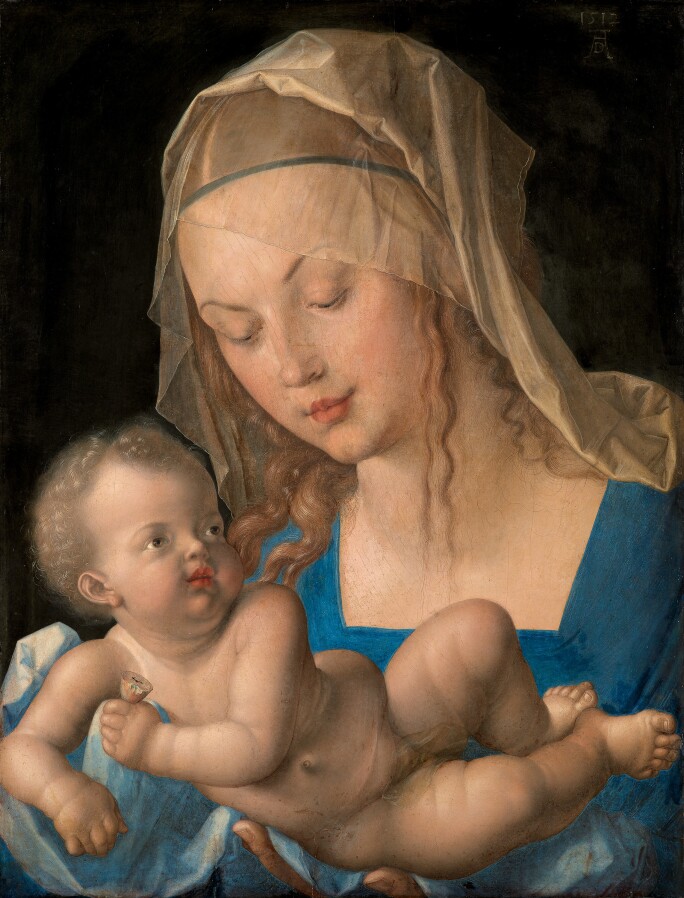R
efined, vibrant, and almost ethereal in its modeling, this painting of circa 1650-1660 by Giovanni Battista Salvi, called Sassoferrato, bears the stylistic hallmarks for which the artist has long been celebrated. These characteristics, enhanced by the canvas’ conservation following its 2012 acquisition, underscore Sassoferrato’s eminent reputation for producing captivating depictions of the Madonna. Indeed, such images—typically known in multiple autograph versions, no doubt a function of their widespread popularity—have been hailed among the most telling statements of seventeenth-century piety.1 As the only known version of this composition, the present painting is, however, unique within the painter’s œuvre.
Sassoferrato situates the Madonna against a plain, dark background that focuses the viewer’s attention on her act of devotion. Her eyes are downcast, and her hands crossed over her breast, invoking a sense of immediacy; the audience witnesses this holy act at close proximity. The strong lighting heightens this feeling and calls attention to the Madonna’s flawless skin, endowing the figure with a sculptural presence. Sassoferrato’s choice of palette, using just three swathes of color, reinforces the composition’s simplicity: the red along the Madonna’s wrists, the white of her shawl, and the dazzling blue of her mantle, for which the artist used the rare and expensive ultramarine pigment.
Although Giovanni Battista Salvi’s sobriquet, Sassoferrato, derives from his town of birth, scholars have described his style as defying regional categorization.2 His artistic personality instead appears to have been shaped by a wide range of influences. Following an initial apprenticeship under his father, Tarquinio Salvi, Sassoferrato traveled to Rome, where he encountered the work of Domenico Zampieri, called Domenichino, and Guido Reni. The Counter-Reformation’s renewed emphasis on the veneration of the Madonna increased the appetite for Marian art throughout Italy, but particularly in the Eternal City. The vogue for moving depictions of the Madonna, such as the present work, prompted the artist to create numerous pictures of this type for sale on the open market, rendering their finish formulaic on occasion. This painting, however, is both exquisitely executed and the only known version of the composition.

Sassoferrato was absorbed by the act of copying the works of earlier masters, including Albrecht Dürer, Titian, and, above all, Raphael. Dürer’s influence can be detected in the Madonna’s pose, with her head tilted toward her proper right shoulder and half-closed eyes, both of which relate to motifs in the German master’s Virgin with the Pear of 1512 in the Kunsthistorisches Museum, Vienna (fig. 1). A comparable depiction of the Madonna by Sassoferrato, though smaller scale, that likewise evidences the influence of Dürer’s Virgin, sold at Sotheby’s, New York, in January 2008.3
According to a label on the painting’s verso, this work was acquired by Henry Currie Leigh-Bennett in December 1880. Leigh-Bennett was a Conservative member of Parliament for the English constituency of Chertsey from 1897 until his death in 1903. Alongside his political duties, he was a director at the London and South Western Railway and a fellow of the Royal Society of Literature. Leigh-Bennett inherited Thorpe Place, Chertsey, upon the death of his father, Reverend Henry Leigh-Bennett, in 1880. It seems likely that he acquired the present work during a redecoration of the property in the same year. Although the painting was moved from Thorpe Place in the 1920s or 1930s, following the house’s sale, it descended in the same family collection until 2012.
When this painting last appeared for sale at Sotheby’s London in 2012, Professor François Macé de Lépinay endorsed the attribution to Sassoferrato after first-hand inspection. He suggested that the Madonna may represent the Virgin Annunciate and originally may have hung alongside a pendant depicting the Archangel Gabriel, as is the case for two pictures in the Pinacoteca Comunale, Cesena.4 We are grateful to Professor Massimo Pulini for endorsing the attribution to Sassoferrato on the basis of digital images.
Please note that this work will be included in the forthcoming catalogue raisonné by François Macé de Lepinay and Vincenzo Mancuso.
1 F. Russell, “Sassoferrato and his Sources: A Study of Seicento Allegiance,” in Burlington Magazine 119, no. 895 (October 1977), p. 695.
2 Russell 1977, p. 695.
3 New York, Sotheby’s, 24 January 2008, lot 70, for $193,000.
4 F. Macé de Lépinay, in Giovan Battista Salvi "Il Sassoferrato,” exhibition catalogue, Cinsello Balsamo 1990, pp. 56, 58-59, cat. nos. 9, 11, both reproduced.